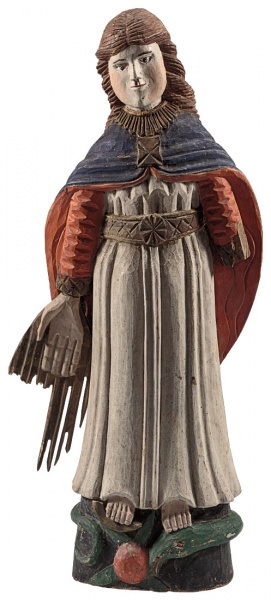Telšiai district
The main feature of the image of Our Lady of Grace is the rays emanating from the hands. They emphasise the meaning of the image, and were therefore often highlighted, carved in the shape of a large fan, and painted yellow, gold or silver, which in Christian iconography symbolises love and heavenly light.
People interpreted the rays coming from Mary’s hands as a sign of favour or answers to their prayers, and so these sculptures were popular on farms, in the belief that Mary would grant the family, the home and the farm her support.
Augustinas Potockis (1844–1945), one of the most productive carvers in Žemaitija, lived in Luokė in the Telšiai district. During his long life he made many crosses and shrines, and more than a hundred sculptures. His sculptures of various saints spread throughout Žemaitija, and even reached Catholic villages in Latvia. They are distinguished by their Žemaitijan monumentality, the stockiness of the proportions, and the broad and expressive faces, which help us to identify his style. He was also careful to carve details and attributes to make his saints easily identifiable. However, he liked to portray certain details of clothing and daily life that are characteristic of his own rural environment. That is why he decorated his sculptures of Mary and other female saints with sashes, recalling traditional woven sashes, and included a segmented four-leaf or eight-leaf star that was very typical in folk decoration. This sculpture of Our Lady of Grace has all the iconographic elements of the subject, and is decorated with a sash and segmented stars.
Text author Skaidrė Urbonienė
Source: Law firm Valiunas Ellex art album
HEAVEN AND BEYOND (2016). Compiler Dalia Vasiliūnienė. Text authors Dalia Vasiliūnienė, Skaidrė Urbonienė
Expositions: “Heaven and Beyond. Works of religious art from the collection of Rolandas Valiūnas and the law firm Valiunas Ellex“,
31 May–
24 September
2016, Church Heritage Museum, Vilnius (curators Dalia Vasiliūnienė, Skaidrė Urbonienė)






